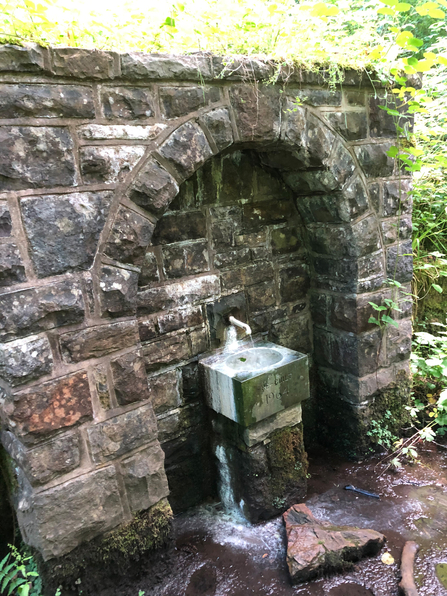We - a couple of friends who can tolerate long walks, geology and wet feet - are in Cumbria, at Birdoswald and heading north through rough grazing and meadows. Also through what looks like several hundred acres of freshly planted, tiny conifers (good to see a few broadleaf saplings too but if I’m honest, I would like to have seen more...).
It’s July and in the wetter hollows meadowsweet (remember its association with clay and ill-drained soils?) is in bloom and fills the air with its scent. Apparently it’s a diuretic and good for UTI’s, but remember my professional prefix is ge-. I’m a ge-ologist not a ur-ologist.
This walk has a definite therapeutic component, although more rational medical men might choose to describe it as homeopathic at best. Before long we find (it wasn’t lost just hard to locate) a Holy Well near Palmer Hill farm. What’s left of a flight of old stone steps takes us down to a ‘sulphurous’ seepage beside King Water - a shadow of its former holy glory no doubt. The water contains hydrogen sulphide; it leaves the ground clear but on contact with air develops a white colloidal bloom and the characteristic smell of rotten eggs. The origin of the gas - the carboniferous shales (geologists prefer to use the word mudstones) through which the water percolates slowly. More of springs and spas shortly.
After reaching Tumbler Rigg, we turn south, the mysterious establishment of Spadeadam is to our left and we keep eyes peeled for the elusive goshawk; although with all the booms and bangs maybe it’s not surprising that, yet again, we don’t see one. We give Crammel Linn, a waterfall on the Irthing, a wide berth. The road has been closed anyway since a hot day in late June when this natural beauty spot was left strewn with litter, and access to farms blocked by abandoned cars. NWT, like other countryside organisations, seeks to encourage people to enjoy nature, but sporadic irresponsible and disrespectful use, here and elsewhere in the UK during lockdown, means that there is more work to be done on public information.
Before long we drop into the Irthing gorge and seek out the Popping Stone, the rock where Walter Scott is reputed to have proposed to Miss Charlotte Carpenter in 1797. You won’t be surprised to hear me say that, without geology, literature and romance would be poorer - without these Carboniferous sandstone boulders, Scott would have had nowhere to propose, QED.


